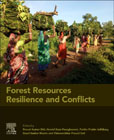
Forest Resources Resilience and Conflicts: Mapping, Modeling, and Managing for Sustainable Livelihood
Shit, Pravat Kumar
Pourghasemi, Hamid Reza
Adhikary, Partha Pratim
Bhunia, Gouri Sankar
Sati, Vishwambhar Prasad
Forest Resources Resilience and Conflicts: Mapping, Modeling, and Managing for Sustainable Livelihood presents modern remote sensing and GIS techniques for mapping, monitoring, measuring, and modeling forest resources. The book provides an up-to-date critical analysis of the discourse surrounding forest resources and society, illustrating the relationship between forest resources and the livelihood of local people. The book is organized into five parts. Each chapter reviews current understanding, present research, and future implications. The book is a valuable resource for researchers and students in environmental science, especially those interested in forestry, geography, and remote sensing. Utilizing case studies and novel advances in geospatial technologies, this reference provides a timely synthesis of a rapidly growing field and stimulates ideas for future work, especially in light of sustainable development goals. The book presents the effective contribution of the forestry sector to population livelihoods through improved collection of forestry statistics that foster understanding and integration of the forestry sector in poverty reduction processes and the national economy to enhance its integration in national planning. It is a valuable resource for researchers and students in environmental science, especially those interested in forestry, geography, and remote sensing. Demonstrates the measurement, monitoring, mapping, and modeling of forest resources Explores state-of-the-art techniques using open source software, R statistical programming, and GIS, focusing on recent trends in data mining and machine learning Addresses a wide range of issues with both environmental and societal implications Provides a global review of the multiple roles of forest resources, utilizing case studies to illustrate management strategies and techniques INDICE: Part I: Geospatial based Forest Resources Mapping, Monitoring and Modelling 1. Application of RS-GIS for forest resources assessment 2. Assessment of Forest Health using modern techniques 3. Deforestation and forest fragmentation 4. Biomass, Carbon Stocks and Pools 5. Forest fire and forest degradation 6. Geospatial artificial intelligence for forest resources modelling Part II: Non-timber Forest Products for Livelihoods & Poverty Alleviation 7. Non-timber Forest resources and socio-economic development 8. The role of timber and non-timber forest products in poverty reduction 9. Medicinal plants and tribal livelihoods 10. The role of communities in sustainable land and forest management Part III: Agroforestry Management in an Ecological and Socio-Economic Context 11. Agroforestry for Soil and water conservation 12. Agroforestry system and soil health 13. Agroforestry and livelihood security 14. Agroforestry and Soil Carbon management Part IV: Joint Forest Management and Socio-Economic Issues 15. Joint Forest Management Present, past and future 16. The role of community participation in forest management 17. The role of NGOs in sustainable forest management 18. Socio-economic Activities and Joint Forest Management Part V: Conflicts on forest resources and way to mitigation 19. Shifting cultivation 20. Forest Ecosystem services and Biodiversity 21. Forest management approaches for coping with the uncertainties of climate change 22. Forest Restoration and conservation 23. National / International Policies of Forest system and land management planning 24. Ecosystem service trade-off for adaptive forest management
- ISBN: 978-0-12-822931-6
- Editorial: Elsevier
- Encuadernacion: Rústica
- Páginas: 470
- Fecha Publicación: 01/06/2021
- Nº Volúmenes: 1
- Idioma: Inglés
